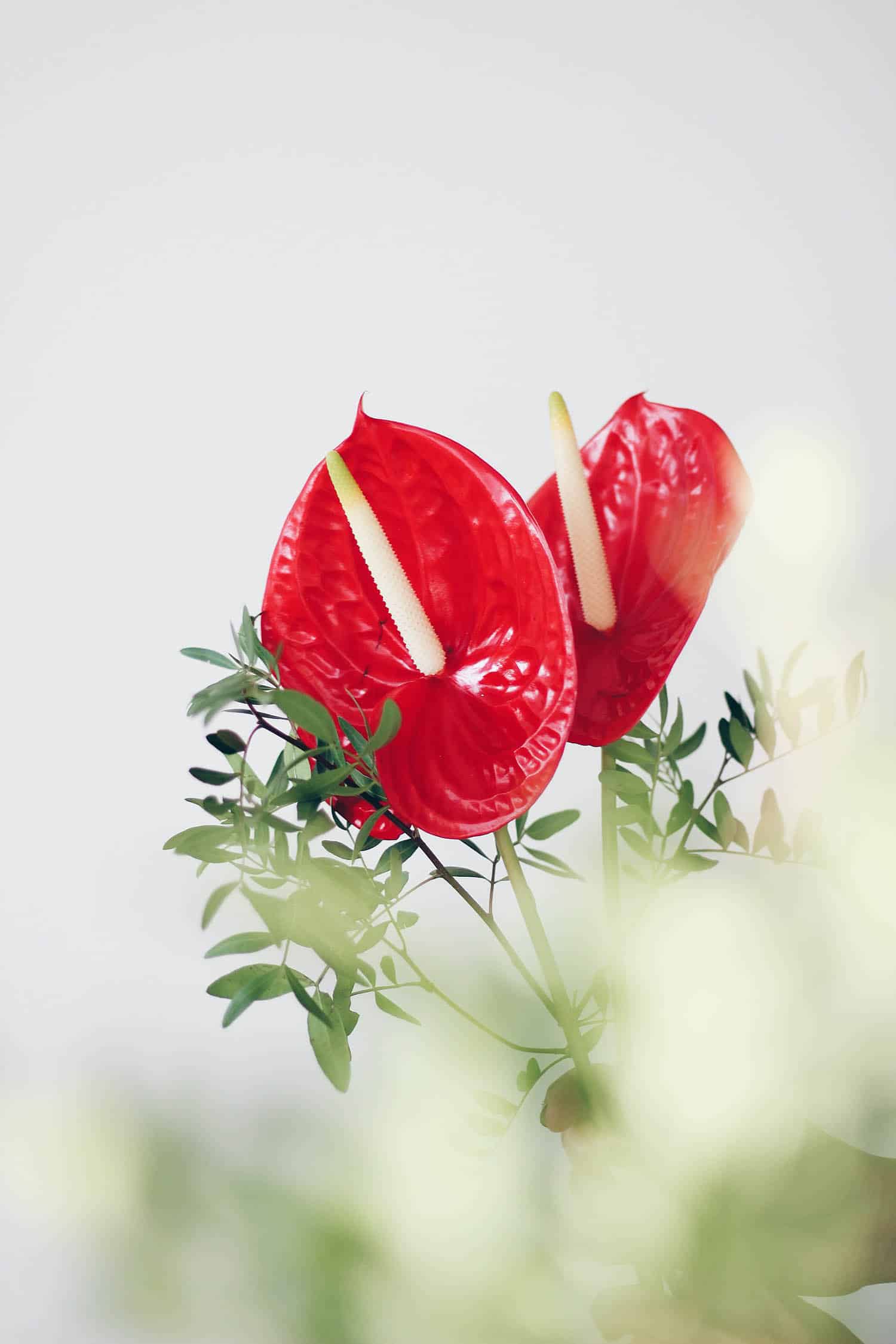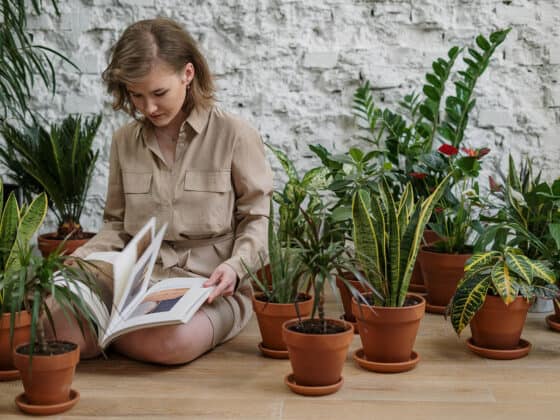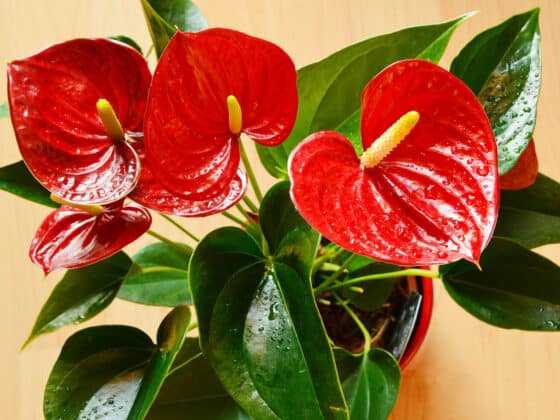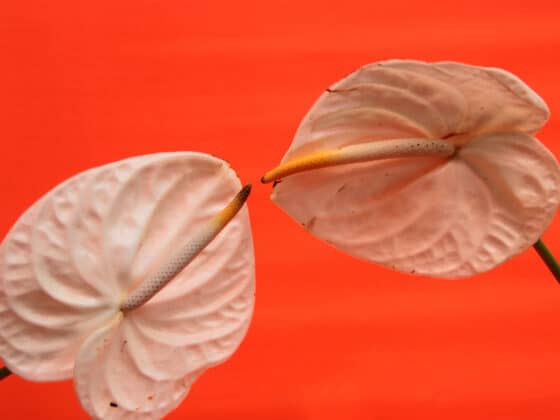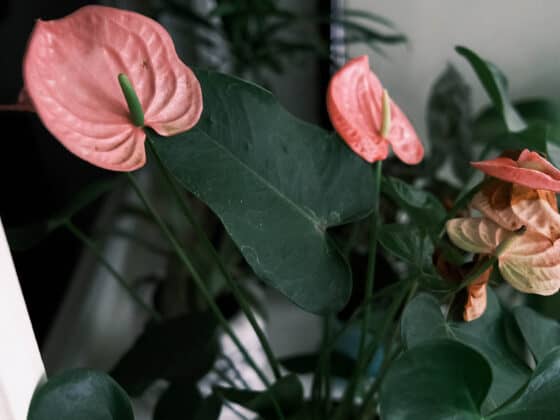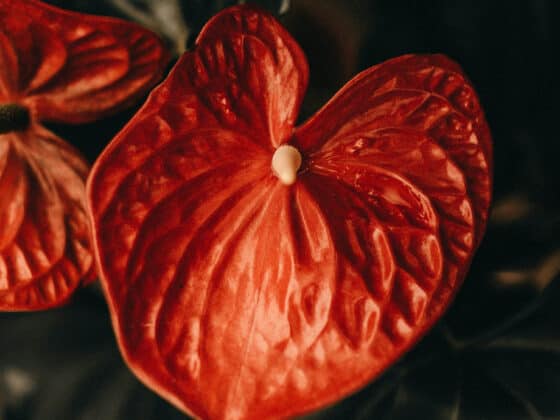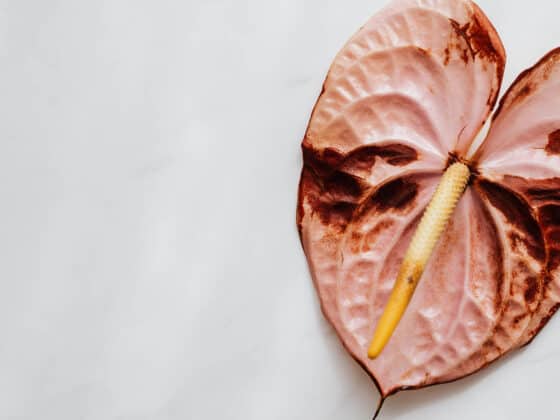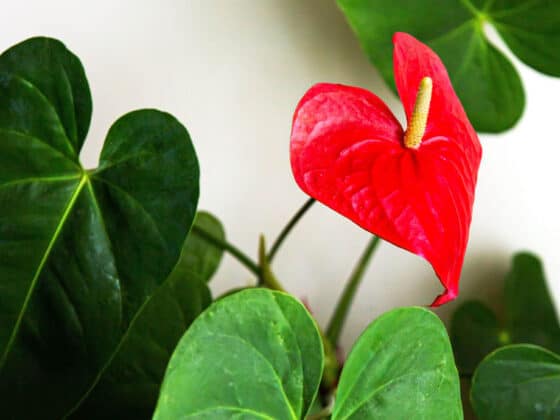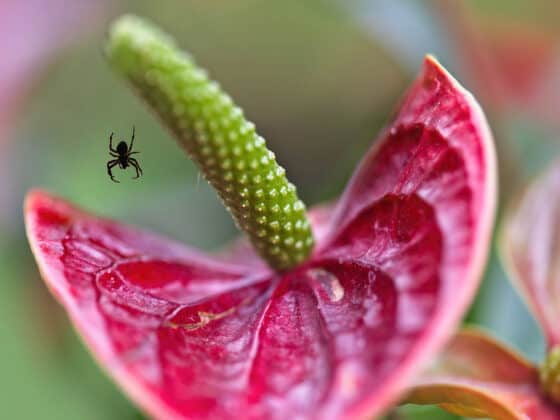The striking blooms of Anthuriums and Peace Lilies are very similar in structure, with a bumpy central spike rising from the base of a single large petal, and both plants thrive in very similar growing conditions. Are they different species? Or is Anthurium a lesser-known type of Peace Lily?
Anthurium and Peace Lily are different plants, though they are closely related in evolutionary terms. Both are aroids – members of the Araceae family, which includes many popular houseplants. “Peace Lily” is the common name of the genus Spathiphyllum, while Anthuriums form a distinct genus of their own.
You can spot some of the differences by inspecting the foliage and flowers. Anthurium leaves are more heart-shaped, and the colorful portion of the bloom tends to lay flatter, while the bright white spathe of a Peace Lily typically curves up like the hood of a cobra. Despite these cosmetic differences, however, these plants have near-identical care requirements.
What Is a Peace Lily?
Despite the name, a Peace Lily isn’t what botanists would call a true lily. That distinction is reserved for members of the Liliaceae family, which includes classic species like the Madonna Lily and the Tiger Lily.
The blooms of a Peace Lily bear a passing resemblance to the white flowers that appear in grocery stores during the Easter season, but their anatomy is wildly different.
The large white “petal” of a Peace Lily is actually a specialized leaf called a spathe – hence the Latin name for its genus, Spathiphyllum. The actual flowers are the small nubs covering the spike (called a spadix) that grows up in front of the spathe.
In essence, each bloom on a Peace Lily is cupping a whole bouquet of miniature flowers! The combined structure is called an inflorescence.
This setup – a large, bright spathe displaying a small, cylindrical spadix – is characteristic of the Araceae family of flowering plants. Members of this family are often called aroids, and there are over three thousand of them. Anthuriums are in this group as well, and so are many other well-loved houseplants, including Philodendrons, Monsteras, Arrowhead Vines, Pothos, and ZZ Plants.
Anthurium and Peace Lily – Similarities
Don’t feel too bad if you assumed a Peace Lily was just a species of Anthurium with white flowers. These two types of plants are similar in many ways, and they occupy neighboring branches on the aroid family tree. We’ll look at a few – though by no means all – of the things they have in common.
Behavior
The inflorescences produced by these two species don’t just look similar – they also behave in much the same way, appearing first as slender, tightly folded spears and opening wide as they mature.
Peace Lilies and Flamingo Flowers also remain in bloom for longer than most houseplants, typically around two months, and can produce blooms year-round in the right conditions.
Both Anthurium and Spathiphyllum sometimes live as epiphytes. That means they can climb up other plants and forgo the soil entirely, getting all the water and nutrition they need from rain, vapor, and falling scraps of vegetation. They accomplish this by producing aerial roots, which help them cling to nearby objects and absorb moisture from the air.
Growing Conditions
Anthuriums and Peace Lilies both prefer indirect or filtered light in large quantities. Keep them in well-lit rooms but away from windows because the direct sun can cause color fading and sunburns.
Both plants prefer a similar temperature range – between 65 and 90 degrees Fahrenheit – and both like humid air. This makes them popular choices for adding a touch of greenery to a bathroom.
The similarities between Peace Lilies and Anthuriums extend below the surface. These plants thrive in the same type of potting mix: a loose, well-draining blend of coarse ingredients. These plants have roots that require lots of oxygen, and they’ll fare poorly in a soggy, dense medium.
Defenses
One other similarity to remember: both Peace Lilies and Anthuriums are mildly toxic. Like many aroids, they produce calcium oxalate crystals in their leaves and sap. This chemical can irritate the skin, and if swallowed, it leads to nausea, difficulty swallowing, and a burning sensation in the mouth.
This won’t be an issue as long as you use gloves when trimming the plant and don’t try to eat it. But those with pets or small children should keep these plants well out of nibbling range.
Fortunately, if one of your less cautious family members has eaten an Anthurium or Peace Lily leaf, they shouldn’t suffer any serious or lasting harm. The sap isn’t deadly to humans or animals, just very unpleasant.
Anthurium and Peace Lily – Differences
We could probably list another ten paragraphs of similarities between Anthuriums and Peace Lilies, but you’re probably more interested in how to tell them apart.
Flowers
Distinguishing these plants is relatively simple when they’re flowering. The spathes of a Peace Lily in full bloom are always white, while those of Anthuriums can display vivid shades of red, purple, or pink. That’s one reason they’re often known as Flamingo Flowers.
Unlike Peace Lilies, Anthurium spathes have a waxy texture and a bright sheen. And Peace Lily spathes don’t typically lay at right angles to the spadix, which is common in Anthuriums. Instead, Spathiphyllum cradles its array of tiny florets within a curved, upright spathe.
Foliage
The leaves of a Spathiphyllum are usually narrower and more ovoid than those of a Flamingo Flower. Anthurium leaves can vary dramatically between species, but most are vaguely heart-shaped, with two large curves sweeping back from the junction with the petiole.
Peace Lilies also have a bit of a reputation as drama queens – they often slump and droop noticeably when they’re thirsty, as though they’re trying to tug at your heartstrings. Anthuriums aren’t prone to these theatrics.
A word of caution, though. Some inexperienced growers assume you should just wait until a Peace Lily wilts before watering it, but if you make a habit of this, you may stress and damage your plant. It’s usually better to test the soil periodically, watering when the top inch or so has become dry.
This is the same watering practice we recommend for Anthuriums; take a look at the advice in this article, which will serve you well when caring for a Peace Lily too.
Propagation
Many aroid houseplants are fairly hardy and can be multiplied from stem cuttings. Anthuriums are a prime example – even a small section of their main stalks can transform into healthy plants when rooted in the right growing medium. Unfortunately, you can’t do this with Peace Lilies, which lack the tough, woody stem of a Flamingo Flower.
However, both species do sprout distinct clusters of stalks that can form new clones if you divide them from the main root ball. In some ways, this method is easier than propagation from cuttings. You often won’t need any tools at all – simply uproot the plant, tug it apart by hand, and repot each section.
For more information on taking Anthurium cuttings, read this article. And click here if you want to learn how to divide an Anthurium for propagation.
Habitat
If you ever find yourself searching for a Peace Lily in the tropical rainforests that many aroid plants call home, don’t look up. You’re more likely to encounter a Spathiphyllum growing by the side of a bog or a stream than high in a tree. These plants can climb high if they need to, but it’s not their preferred lifestyle.
By contrast, Anthuriums often seek the high ground. Only a few species grow in the watery environments preferred by Peace Lilies. Don’t take that as carte blanche to overwater your Spathiphyllum, though. A pot is a very different environment than a marshy jungle, and there’s definitely such a thing as too much water for your Peace Lily.
Final Thoughts
Anthurium and Spathiphyllum aren’t the same, but many of their differences are obvious only to botanists. When it comes to indoor growing, their requirements are almost identical – bright, indirect sunlight, a loose, airy potting mix, and a humid atmosphere.
Both plants make gorgeous additions to almost any home. So if you really want to learn what makes them unique, why not get one of each and see for yourself?






